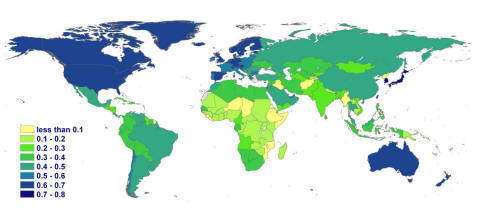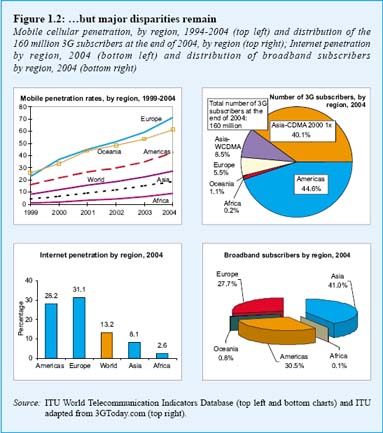By Ismael Peña-López (@ictlogist), 05 October 2006
Main categories: e-Readiness, ICT4D
No Comments »
Stéphan Gagnon, Patrick C.K. Hung, Katia Passerini and Miguel Vargas Martin, have edited a special issue of the International Journal for Infonomics on e-Readiness, entitled Measuring e-business for Development.
The table of contents looks appealing enough even for those interested in ICT indicators, or e-readiness, out of the e-business focus:
Measuring e-business for Development
Gagnon S., Hung P.C.K., Passerini K. and Vargas-Martin M.
Measuring the Diffusion of e-Business in the Information Society
Salmeron J.L., Banuls V.A.
Assessing e-Business Capabilities and Effectiveness: A Set of Key e-Business Metrics
Chatterjee D., Segars A.
E-governance in India: A Strategic Framework
Mahapatra R., Perumal S.
Synthetic indicators for measuring e-business: A target approach
Vilaseca J., Meseguer A., Torrent J.
Measuring e-business in Developing Countries
Teltscher S.
Toward a Multilateral Effort in Measuring e-Business for Development
Gagnon S.
By the way, the journal’s architecture is an odd one: there is just a sigle issue dated January 2005 and a second issue permanently “fortcoming” (due to July 2005). You might think the journal is the old story of good intentions never sustained, but no: there are five special issues, two of them (one unpublished) dated 2006. Weird.
By Ismael Peña-López (@ictlogist), 10 July 2006
Main categories: Connectivity, Digital Divide, e-Readiness, Hardware, ICT4D
No Comments »
New report developed by the International Telecommunication Union, the UNCTAD, the Ministry of Information and Communications of the Republic of Korea and the Agency for Digital Opportunity & Promotion (KADO).
This report charts progress towards the Information Society, in response to the call by the WSIS Geneva Plan of Action, for evaluation and international benchmarking, as well as the need for monitoring of WSIS follow-up and implementation (noted in the WSIS outcome documents). It evaluates access to telecommunications and digital opportunity in 180 economies worldwide in the context of the WSIS targets and Millennium Development Goals. It presents the Digital Opportunity Index, as called for by the WSIS Geneva Plan of Action, paragraph 28, and considers the policy implications for the further evolution of the Information Society. It reviews WSIS implementation and follow-up in different countries, and considers efforts to promote ICT development. It also presents the latest available data on 180 economies worldwide.
It is intended that the “The World Information Society Report” will be an annual publication.
So, it seems that the transition from the Digital Access Index and the Digital Opportunity Index has been done. Nevertheless, looking at who is backing the new report and, hence, the DOI, I guess there’s still some time until the Partnership on Measuring ICT for Development becomes really functional. I suppose it’s likely that next edition will be signed by the Partnership in its whole.

Digital Opportunity Index 2005. Source: World Information Society Report 2006
[click to enlarge]
The main two reflections that come to mind — besides the most evident about the digital divide and wealth distribution/opportunity-to-access in the world — are:
- There’s a urgent need to stablish an index covering the whole range of the digital divide and not just infrastructures: digital literacy, content and services use and policy, legal framework.
- Disturbing content and Diverted to bad sites stands for only 7% of the greatest online fears, being cibercrime (in its many faces) up to 91%. This makes me think about the unbalanced efforts made in censorship apps, filters and regulation by paternalist Governments in front of the real needs as perceived by users.
By Ismael Peña-López (@ictlogist), 14 June 2006
Main categories: e-Readiness, ICT4D
No Comments »
Here come two resources to help understand the resemblances and differences among indexes to measure the Information Society.
The first one:
is a comparison of all (or almost, who knows one year after) the existing indexes
The second one:
is an essay led by the International Telecommunication Union to collaborate internationally to measure the digital divide: the Digital Opportunity Index
By Ismael Peña-López (@ictlogist), 25 May 2006
Main categories: Digital Divide, Digital Literacy, e-Readiness, ICT4D
No Comments »
As promised — I did it by e-mail ;) — here come the presentations I intend to use in little more than an hour here in Trento. Click to see the abstracts and/or download them.
By Ismael Peña-López (@ictlogist), 25 May 2006
Main categories: Digital Divide, e-Readiness, ICT4D
3 Comments »
It’s been monts since last ITU’s World Telecommunication/ICT Development Report saw the light, but it’s not been until an accurate reading to prepare my tomorrow’s seminars that I realized the following statement:
ITU statistics show that over the last 10 years, the digital divide between the developing and the developed countries has been narrowing in terms of fixed telephone lines,
mobile subscribers and Internet users.
This was also stated by this year’s e-Readiness Rankings and I then disagreed. But now, now I got data.

[click to enlarge]
As can be seen, digital divide comparisons among developed and developing countries are relative, in %. According to this, its true: digital divide is narrowing. In 1994, mobile penetration for developing countries was about to 5% and less than 0.2% for developing ones. With a 77% penetration in 2004, developed countries have “just” four times mobile penetration than developing (19%). But take a closer look. In 1994, developed countries were almost 5 points ahead than developing in mobile penetration. Ten years later, they are 58 points ahead. If we look it this way, in absolute terms, the digital divide has widened 11 times the existing gap.
For fixed lines, either the way you look at it, the divide has narrowed, though the relative approach or the absolute one differs slightly. While the first one shows a very important decrease of the digital divide, the latter just tells us that the situation is about the same. Besides: who cares for fixed lines when the world is going mobile?

[click to enlarge]
The second image is even sadder: how can one say that the digital divide is narrowing when almost all 3G mobile phones are in developed countries? And how can one say that the digital divide is narrowing when almost all broadband is in developed countries? (don’t let you be tricked: America’s 30% of broadband is the old story about me having two apples, you having none and, hence, you and me having one apple in average).
Put in other words: yes, developing countries are having more and more bicycles to travel away. But the rest of the world is already driving fast cars. And the worst part of it: digital content and services provision requires more and more computer power and broadband. Unless things change and someone starts to design information containers and communication applications that run on $100 computers, noone cares about fixed telephone lines and 1G mobile phones.
So, can you explain to me again this thing of a narrowing digital divide?
To check yourself:
By Ismael Peña-López (@ictlogist), 18 May 2006
Main categories: Digital Divide, e-Readiness, ICT4D, Meetings
1 Comment »
Though it is designed as an open debate among students and the speaker, I’m giving unilaterally a name to the second seminar I’m imparting in Trento — From e-Readiness to e-Awareness (or the way back) — just to give an idea about what I guess it is going to deal with. I was asked by the organization to please suggest some basic bibliography for the students to read and prepare some questions so the debate could be started.
I here present v2.0 of my initial list, somehow improved (or impovered, yours to judge) with 3 more references. There it goes:
I’d like to add to these my following posts:
From all of these, Tongia et al. is quite long and specific (but interesting enough to be in this list). The other ones I think they are accessible to any kind of learner.


 Full Report
Full Report

